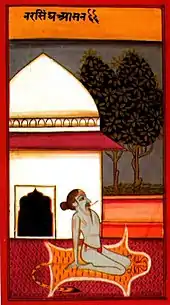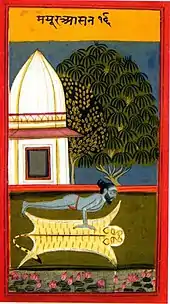Simhasana
Simhasana (Sanskrit: सिंहासन; IAST: Siṁhāsana) or Lion Pose[1] is an asana in hatha yoga and modern yoga as exercise.

Etymology and origins

The name comes from the Sanskrit words simha (सिंह), meaning "lion", and āsana (आसन), meaning "posture" or "seat".[2] The pose has also been named Narasimhasana, as in the 19th century Joga Pradipika,[3] from Sanskrit नरसिंह Narasimha, a lion-man avatar of the god Vishnu.[4] The posture is described in the tenth century Vimānārcanākalpa.[5]
Description
The practitioner kneels with the buttocks on the inner arches of the feet, stretches the arms forwards with the hands outspread just off the ground, and makes a facial expression with the mouth open wide and the tongue out to resemble a lion. The yoga guru B. K. S. Iyengar notes that this is the traditional pose; he calls it Simhasana I.[6]
Variations
Iyengar's Simhasana II begins from lotus position (Padmasana). The practitioner then stands on the knees and moves the body forwards until the front of the body faces the floor and the shoulders are directly above the hands, the arms straight. The facial expression is the same as before.[6]
Yoga Journal has described a variant "Lion Pose" with the legs as in Muktasana with the facial and hand positions as in Simhasana, suggesting it as a suitable seat for pranayama.[7]
See also
- List of asanas
- Virasana, another ancient kneeling pose, without the facial gesture
References
- "Yoga Journal - Lion Pose". Retrieved 2011-07-03.
- Sinha, S. C. (1996). Dictionary of Philosophy. Anmol Publications. p. 18. ISBN 978-81-7041-293-9.
- Bühnemann, Gudrun (2018). 84 Asanas in Yoga. D.K.Printworld. p. 59 (plate 68).
- Williams, George M. (2008). Handbook of Hindu Mythology. Oxford University Press. p. 223. ISBN 978-0-19-533261-2.
- Mallinson, James; Singleton, Mark (2017). Roots of Yoga. Penguin Books. pp. 100–101. ISBN 978-0-241-25304-5. OCLC 928480104.
- Iyengar, B. K. S. (1991) [1966]. Light on Yoga. Thorsons. pp. 135–138. ISBN 978-0-00-714516-4.
- YJ Authors (28 August 2007). "Lion Pose". Yoga Journal. Retrieved 27 August 2021.
Further reading
- Saraswati, Swami Janakananda (1 February 1992). Yoga, Tantra and Meditation in Daily Life. Weiser Books. ISBN 978-0-87728-768-1. Retrieved 11 April 2011.
- Saraswati, Swami Satyananda (1 August 2003). Asana Pranayama Mudra Bandha. Nesma Books India. ISBN 978-81-86336-14-4. Retrieved 9 April 2011.
- Saraswati, Swami Satyananda (January 2004). A Systematic Course in the Ancient Tantric Techniques of Yoga and Kriya. Nesma Books India. ISBN 978-81-85787-08-4. Retrieved 9 April 2011.
_from_Jogapradipika_1830_(cropped).jpg.webp)

